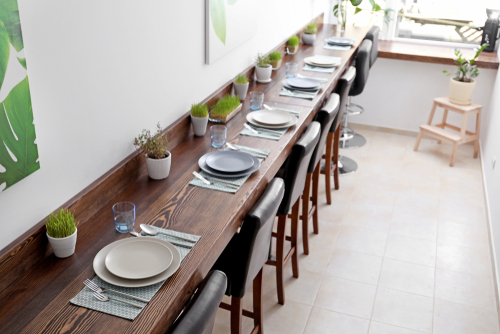Salad with a Side of Style: Why Sweetgreen Is Investing in Design
Come for the Harvest Bowl, stay for the artwork—at least that’s what the team behind the hip, health-conscious lunch spot Sweetgreen hopes you do. Since its founding in Washington, D.C., 11 years ago, the chain has set itself apart with fresh ingredients combined in creative ways, yes, but also with an aesthetic that makes the rush of a weekday lunch less of a doldrum and more of an upbeat escape. And that’s no accident. Founders Nicolas Jammet, Nathaniel Ru, and Jonathan Neman have been adamant from the start that Sweetgreen’s interiors live up to the same standard they set for their ingredients, working with talented architects and artists to devise and decorate spaces that are recognizable without being overly branded, and memorable without veering trendy.
Like many good designers, the team starts with a concept. Unlike many of the designers AD often covers, though, that concept isn’t an aesthetic style or period; rather, it’s the food in your compostable cardboard to-go bowl. “We want to create spaces that can tell a great story,” Ru says. “For us, that’s the food, that’s our product. So we ask ourselves, How do we create a physical space that’s functional but communicates our values, which start with the ingredients?”
Walk into any Sweetgreen and you’re likely to be confronted head-on with the second part of the chain’s name. “When you look in the kitchen you see this wall of bountiful produce, which is both functional and also puts the attention on the produce,” Jammet says. “We put a lot of attention on how and where we supply, so being able to use design to spotlight that is really important.”
In addition to the functional riff on the green wall, most Sweetgreen locations feature some combination of raw wood, white walls, and chalkboards, elements that read natural and, perhaps more importantly, understated. “We’re big believers in constant evolution and trying new things,” Jammet explains. “So our foundational look and feel is natural and timeless and feels inviting. We don’t want a space that will feel outdated in a year.”
Beyond avoiding stylistic expiry, the subdued interiors (which have been conceived by an impressive roster of architects including ASH Design, Leong Leong, and Jensen Architects) offer the opportunity for Sweetgreen to explore its second passion after food: art.
”Because we have a very clean aesthetic, it’s a great canvas to showcase art,” Jammet says. A bit part of Sweetgreen’s ethos is local sourcing, and this supply-chain strategy is echoed in its work with (often local) artists. The team frequently works with art collective Tappan to find partners, though it also often finds itself making connections in a more (aptly) organic way: They’re customers who eat at Sweetgreen.
The latest in Sweetgreen’s artist series is a project with graffiti artist André Saraiva,who has created a riff on his “Dream Concerts” posters, which imagined impossible musical collaborations. In “Dream Dinners,” Saravia (known by his tag Me. A), highlights fantasy collaborations between chefs through the ages (Julia Child, Dominique Crenn, Jacques Pépin, and Wylie Dufresne are just a few of the names).
Though the Dream Dinners activation is multi-location (the posters will be on display in Sweetgreen’s La Brea, NoMad, and Georgetown locations), more often than not the company’s artist collaborations are a way for it to zero in on one specific area, offering a hyperlocal installation that makes Sweetgreen feel less like a nationwide chain and more like a neighborhood joint. It’s a strategy akin to programs like West Elm’s Local and Starbucks’s Reserve Roastery programs, which aim to distance big-name brands from stereotypical centrally controlled corporate culture.
“Our approach to design is really regional,” confirms Jammet. “When we go into any new city or neighborhood, the second thing we do after visiting farms is really try to understand the city and the people and build our store around that feeling and the people we connect with. The art is somewhere we’ve gone pretty deep because we’re able to create localized moments that connect with not just the customers but the larger community.”
“One of the things we’ve always challenged ourselves with is how do we not just make another Sweetgreen, but make it feel like your Sweetgreen,” adds Ru. “Most fast food places don’t invest in that, but we really enjoy doing it. It gives us a strong connection to the community and allows us to be students of wherever we are.”

